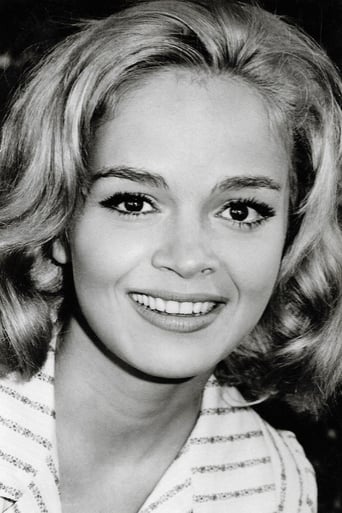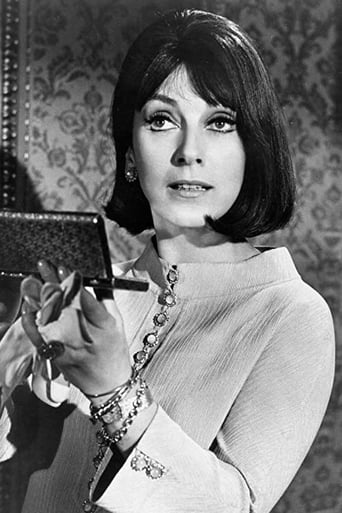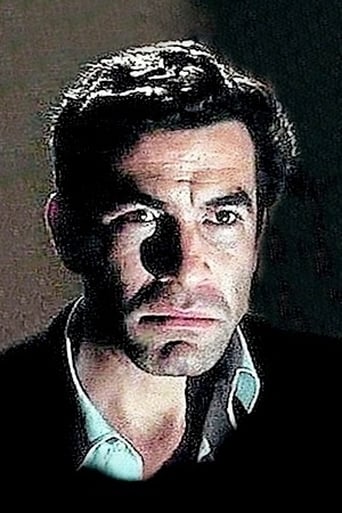Grimerlana
Plenty to Like, Plenty to Dislike
Spidersecu
Don't Believe the Hype
Robert Joyner
The plot isn't so bad, but the pace of storytelling is too slow which makes people bored. Certain moments are so obvious and unnecessary for the main plot. I would've fast-forwarded those moments if it was an online streaming. The ending looks like implying a sequel, not sure if this movie will get one
Geraldine
The story, direction, characters, and writing/dialogue is akin to taking a tranquilizer shot to the neck, but everything else was so well done.
Bezenby
The first Giallo, or so I've heard. Before the Giallo was the German Krimi films, also murder mysteries with a fair bit of comedy, I understand. Of course, the Giallo were based on the yellow murder mystery books on sale in Italy at the time, and before that was Agatha Christie, and so on and so forth. However, the Giallo Mario gives us is full of future clichés, but almost right away Bava starts messing with the genre! Oh, you, Bava.Nora arrives in Rome from New York and immediately starts having a really bad day. The guy hitting her on the plane was smuggling drugs, the Aunt she was visiting dies of a heart attack that night, and she gets mugged on the Spanish Steps. Not only that, but while reeling from a sore head after getting mugged, she thinks she sees a woman getting stabbed in the back by a fella! The only good thing that happened was that she met Marcello, a hunky young doctor played by John Saxon. Saxon's all out to help Nora get to the bottom of the mystery (there's no body and nobody believes her) but I think Marcello is just trying to get into her pants.Nora moves into an apartment next to the Spanish Steps and Bava clues us in right away that this is a bad move by sliding the camera towards a mysterious locked door before Nora even notices it, then a framed picture of the man Nora thought she spotted during the murder. Uh oh! Bava does this a lot during this film, and to be honest that's why I'm such a fan of his work. Every part of this film is beautifully constructed, from the scene were Nora is drawn to an apartment where the bare lightbulbs sway in the wind of an open window while an unseen voice talks and taunts Nora, to the use of shadows even in the most routine of scenes (like the printers, were a simple 'tracing a character' scene becomes a lovely display of shadows on fabric). The only thing that doesn't work out is some of the comedy, although it is funny that Saxon ends up with various injuries as the film carries on.My favourite scene is when Nora visits someone else investigating the murders, and from outside the apartment hears the hammering of a typewriter. After trying to get the person to open the door, she finds it open, and the camera pans across the room...to a disused typewriter...then to a tape recorder playing the sound of someone typing. I love it when Bava does this and he takes it to extremes in later films.This early Giallo was not successful, and it would take until the international success of Dario Argento's The Bird With The Crystal Plumage to launch the genre into overdrive. However, it does give me the chance to use the phrase Chiaroscuro and sound well wanky, for Bava use of the contrast between light and dark hints towards theory I have that these guy involved in Italian cinema aren't that far removed from the artists that populated Rome back in the days of Caravaggio.
secondtake
The Girl Who Knew Too Much (1963)Well, this is a classic worth watching for film buffs interested in the first giallo movie ever made (if we ignore the Hitchcock precedents). Giallo films are purposely simple and gory and filled with dramatic camera-work. In a sense they play off the style, one after another, becoming increasingly about the genre rather than movies that stand on their own. It's like slasher films these days, or maybe even zombie films, where you watch knowing what you're going to get, and that's exactly what you want.Even the director, Mario Bava, admitted openly this was a silly film with great cinematography. That sums it up. He couldn't even remember the two leading actors. There is a bizarre, cheesy, low-budget thriller aspect to the whole enterprise that makes it fun in a campy way even if you aren't a giallo fan. But it's not good in a traditional sense.Even the main premise is old as the hills--a serial killer is stabbing women in the back in alphabetical order by last name. This is oddly confused in the plot, because woman C was killed a decade before and we see the next woman killed before our eyes. But the heroine's last name begins with D, as if she is going to be next, and indeed she finds her picture in a file at the end suggesting she really is next in line. So what letter did the woman killed before our eyes have?One of the weird aspects to the plot might explain this--the woman accidentally smokes a marijuana cigarette at the beginning of the movie, and we come to realize she might have dreamed the whole episode. Never mind there are other deaths and mishaps that seem rather real. And a handsome Italian doctor in love with her.It's also weird in a funny way that the lead woman is an Italian actress playing an American visitor in Rome. Naturally her Italian is excellent. And the whole movie is centered around the Spanish Steps, which are often completely (completely) empty, not a person around. Adds to the surrealism. There are creaky horror film conventions like the shadowy man seen through the window, or the overdecorated house with creepy lights where the woman is staying, alone of course.What's to recommend this? The photography. The noir influence (and the Roger Corman one, I suppose) is clear. And beautiful. Now if the story and acting made some modicum of sense we'd be set for a classic over-the-top scary movie. Yes, it's important as a giallo example, but don't overblow the result.
chaos-rampant
Coming out in 1963, The Girl Who Knew Too Much is not as ground-breaking as other Mario Bava efforts but it's still every bit as stylish and suspenseful. The plot of the film, convoluted and filled with twists and red herrigns galore, anticipates the giallo cycle of the late 60's. Of course one year later the director would practically define the style with Blood and Black Lace, introducing other genre staples like the black-gloved killer, the garish colours and the gore but that doesn't detract from the ifluential status of this proto-giallo.As the title imples, The Girl Who Knew Too Much is with one foot firmly set in Hitchcock territory, but whereas Hitch films had a tendency of trying to be too many things at once (little bits of comedy, romance etc) something I always considered distracting, Bava allows nothing to come between him and his goal: a suspenseful horror thriller.The chiaroscuro photography is simply beautiful to look at, light and shadow play off each other in expressive ways, not unlike film-noir. Leticia Roman's face is at times only half-lit to stress her confusion, while in other set-pieces dark figures stand out against fully lit backgrounds. Bava is famous for being one of the best visual directors in the history of the medium for good reason. His black and white work is as good as his colour films.Minor quibbles I had with the film include that many scares turn out to be false, the first person narration (another film-noir influence) and the implied possibilities in the ending *was it all a dream?* Leticia Roman and John Saxon hit it off with great chemistry, the DP work is fantabulous, the opening 15-20 minutes leading up to the first murder are among the best 20 minutes in 60's horror and this an all around accomplished horror film that deserves every fan's attention.
Graham Greene
The Girl Who Knew Too Much (1963) is director Mario Bava's gleeful homage to Hitchcock; and one of the earliest examples of the Italian Giallo sub-genre of horror/suspense cinema that would go on to inspire an entire generation of horror filmmakers throughout the subsequent two decades. If you're at all familiar with the work of director Dario Argento for example, then you can see the roots of films like The Bird with the Crystal Plumage (1970), Deep Red (1975) and Tenebrae (1982) already being established by the skillful blending of low-key thrills, character development and good old fashioned murder mystery, as captured by Bava in this excellent, slow-burning suspense piece. Although it may take some viewers a while to settle into the overall tone of the film - with those first few scenes presenting us with a veritable bombardment of information, both narrative and thematic, before the first murder has even taken place - the eventual unravelling of the plot, and Bava's excellent direction eventually draw us deeper into a story that is here punctuated by a charmingly romantic subplot, a miniature travelogue around the tourist traps of Rome, some subtle moments of almost slapstick humour, and the director's always inventive use of visual experimentation.The usual Gialli trademarks are already beginning to take shape here, with the film focusing on a foreigner - in this case, twenty-year old American student Nora Davis - who travels to Rome to visit her ailing aunt and inadvertently witnesses a murder. Alongside this central plot device, which would be utilised by Argento in many of his greatest films, such as the three aforementioned, we also have the ideas of sight and perception; with the central protagonist unintentionally witnessing something that is shrouded in elements of doubt and abstraction, and thus having to prove what she saw to sceptical police officers and those nearest to her. Bava's film is also given a neat touch of self-referential sub-text; opening with a shot of the central character herself reading a Giallo murder mystery, casting some doubt as to whether or not the film plays out in the literal sense, or whether it is a merely a constructed reality, taking place in her own mind as she reads the book to herself. This is a thread of interpretation that is examined throughout by the filmmaker, with the title of the book itself, "The Knife", having an importance on the plot that perhaps surreptitiously suggest some element of imagined fantasy.Once we get through those hectic opening sequences, which introduce the characters and a number of potential sub-plots that are essentially window-dressing to throw us off the trail, the film settles into the murder mystery aspect and the burgeoning relationship between Nora and her young doctor friend, Marcello Bassi. Through the relationship, Bava introduces a subtle comment on the Holmes vs. Watson partnership recast as a romantic dilemma, whilst also creating space within his story to let the audience catch up and think about the potential clues already collected in order to lead us to the eventual discovery of the killer's identity. The use of sight and Bava's directorial slight-of-hand is used meticulously for the initial murder sequence; with the director creating a literal feeling of hazy disconnection and a distorted perspective through a somewhat dated visual effect and the always masterful use of light and shadow. Although the actual effect - which replicates the look of ripples on a pond - might lead a more contemporary audience to giggle or cringe, it does tie in with the continual use of water-symbolism in Bava's work, from the final story in The Three Faces of Fear/Black Sabbath (1963), and A Bay of Blood (1971) most famously, as well as a somewhat cheap gag about marijuana cigarettes that will pay off in the film's closing moments.Again, the use of humour taps into the spirit of Hitchcock, with intrigue, voyeurism, suspense and murder being reduced to mere complications in the continual romantic wooing of Nora by the charming Dr. Bassi. Nevertheless, the thriller aspects are what we remember most clearly; with Bava's always atmospheric direction, iconography and ability to create tension from the slightest movement of the camera. Once the credits have rolled, we release just how subtle much of Bava's use of sight and perception actually was; with a number of scenes leading on from a moment of confusion by the central character, in which she thinks she sees something that turns out to be nothing of the sort. Again, it shows the director playfully undermining the central character; presenting Nora as someone unable to trust her own eyes, and thus, unable to be trusted with the ultimate unravelling of the plot. Nonetheless, Bava also succeeds in throwing us into this enigmatic mystery; undermining our own perspective of the story by showing us important information early on, allowing us to feel superior to Nora with our benefit of a forewarning, only to then cast further doubt in our mind as the gallery of suspects mount up.Though still something of a minor work for Bava, The Girl Who Knew Too Much is undoubtedly great; enlivened by the fine performances from the two leads, John Saxon (a cult actor with an impeccable list of credits) and the delightful Leticia Roman (I'm honestly quite smitten), and absolutely brimming with style and energy. The gag at the end is in-keeping with Bava's work, but certainly doesn't lessen the impact of the more thrilling scenes that came before, or the air of grand mystery and excitement suggested by his excellent approach to editing, cinematography and design. Beware that the film also exists under the title The Evil Eye; re-edited by Bava for the American market as more of a light-hearted romp (Tarantino calls it's a masterpiece). The version reviewed here is the original Italian version, a minor masterpiece of Giallo thrills, cinematic abstractions and an old-fashioned approach to storytelling that grips us from the start and never lets us go.






